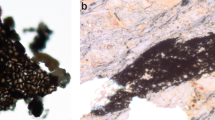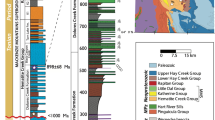Abstract
Phosphorites of the late Neoproterozoic (570 ± 20 Myr BP) Doushantuo Formation, southern China, preserve an exceptional record of multicellular life from just before the Ediacaran radiation of macroscopic animals. Abundant thalli with cellular structures preserved in three-dimensional detail show that latest-Proterozoic algae already possessed many of the anatomical and reproductive features seen in the modern marine flora. Embryos preserved in early cleavage stages indicate that the divergence of lineages leading to bilaterians may have occurred well before their macroscopic traces or body fossils appear in the geological record. Discovery of these fossils shows that the early evolution of multicellular organisms is amenable to direct palaeontological inquiry.
This is a preview of subscription content, access via your institution
Access options
Subscribe to this journal
Receive 51 print issues and online access
$199.00 per year
only $3.90 per issue
Buy this article
- Purchase on Springer Link
- Instant access to full article PDF
Prices may be subject to local taxes which are calculated during checkout





Similar content being viewed by others
References
Buss, L. W. The Evolution of Individuality (Princeton Univ. Press, NJ, 1987).
Han, T.-M. & Runnegar, B. Megascopic eukaryotic algae from the 2.1 billion-year-old Negaunee Iron-Formation, Michigan. Science 257, 232–235 (1992).
Knoll, A. H. The early evolution of eukaryotes: a geological perspective. Science 256, 622–627 (1992).
Whittington, H. B. The Burgess Shale (Yale Univ. Press, New Haven, CT, 1985).
Briggs, D. E. G., Erwin, D. H. & Collier, F. J. The Fossils of the Burgess Shale (Smithsonian Institution Press, Washington DC, 1994).
Kidston, R. & Lang, W. H. On Old Red Sandstone plants showing structure from the Rhynie chert bed, Aberdeenshire. Parts I–Iv. Trans. R. Soc. Edinb. 51, 761–784; 52, 603–627; 62, 643–680; 52, 831–854 (1917–1921).
Remy, W., Gensel, P. J. & Hass, H. The gametophyte generation of some early Devonian land plants. Int. J. Plant Sci. 154, 35–58 (1993).
Zhao, Z., Xing, Y., Ma, G. & Chen, Y. Biostratigraphy of the Yangtze Gorge Area, (1) Sinian (Geological Publishing House, Beijing, 1985).
Zhao, Z. et al. The Sinian System of Hubei (China University of Geosciences Press, Wuhan, 1988).
Sun, W. Late Precambrian pennatulids (sea pens) from the eastern Yangtze Gorge, China: Paracharnia gen. nov. Precambrian Res. 31, 361–375 (1986).
Qian, Y., Chen, M. & Chen, Y. Hyolithids and other small shelly fossils from the Lower Cambrian Huangshandong Formation in the eastern part of the Yangtze Gorge. Acta Palaeontol. Sinica 18(3), 207–232 (1979).
Compston, W., Williams, I. S., Kirchvink, J. L., Zhang, Z. & Ma, G. Zircon U-Pb ages for the Early Cambrian time-scale. J. Geol. Soc. Lond. 149, 171–184 (1992).
Zhang, Y., Ying, L., Xiao, S. & Knoll, A. H. Permineralized fossils from the Terminal Proterozoic Doushantuo Formation, South China. Paleontol. Soc. Mem. (in the press).
Grotzinger, J. P., Bowring, S. A., Saylor, B. Z. & Kaufman, A. J. Biostratigraphic and geochronologic constraints on early animal evolution. Science 270, 598–604 (1995).
Kaufman, A. J., Knoll, A. H. & Narbonne, G. M. Isotopes, ice ages, and terminal Proterozoic earth history. Proc. Natl Acad. Sci. USA 94, 6600–6605 (1997).
Benus, A. P. Sedimentologic context of a deep-water Ediacaran fauna (Mistaken Point Formation, Avalon zone, eastern Newfoundland). Bull. N. Y. State Mus. 463, 8–9 (1988).
Hofmann, H. J., Narbonne, G. M. & Aitken, J. D. Ediacaran remains from intertillite beds in northwestern Canada. Geology 18, 1199–1202 (1990).
Briggs, D. E. G., Kear, A. J., Martill, D. M. & Wilby, P. R. Phosphatization of soft-tissue in experiments and fossils. J. Geol. Soc. Lond. 150, 1035–1038 (1993).
Krajewski, K. P. et al. Biological processes and apatite formation in sedimentary environments. Ecolog. Geol. Helvet. 87, 701–745 (1994).
Glenn, C. R. et al. Phosphorus and phosphorites: Sedimentology and environments of formation. Eclog. Geol. Helvet. 87, 747–788 (1994).
Föllmi, K. B. The phosphorus cycle, phosphogenesis and marine phosphate-rich deposits. Earth Sci. Rev. 40, 55–124 (1996).
Zhu, S. & Wang, Y. in The Upper Precambrian and Sinian-Cambrian Boundary in Guizhou (eds Wang, Y. et al.) 93–103 (People's Publishing House of Ghizhou, Guiyang, 1984).
Zhang, Y. Multicellular thallophytes with differentiated tissues from Late Proterozoic phosphate rocks of South China. Lethaia 22, 113–132 (1989).
Zhang, Y. & Yuan, X. New data on multicellular thallophytes and fragments of cellular tissues from Late Proterozoic phosphate rocks, South China. Lethaia 25, 1–18 (1992).
Awramik, S. M. et al. Prokaryotic and eukaryotic microfossils from a Proterozoic/Phanerozoic transition in China. Nature 315, 655–658 (1985).
Bold, H. C. & Wynne, M. J. Introduction to the Algae (Prentice-Hall, Englewood Cliffs, NJ, 1985).
Fritsch, F. E. The Structure and Reproduction of the Algae Vols 1 2,(Cambridge Univ. Press, 1965).
van den Hoek, C., Mann, D. G. & Jahns, H. M. Algae: An Introduction to Phycology (Cambridge Univ. Press, 1995).
Butterfield, N. J., Knoll, A. H. & Swett, K. Abangiophyte red alga from the Proterozoic of Arctic Canada. Science 250, 104–107 (1990).
Xiao, S., Knoll, A. H. & Yuan, X. Morphological reconstruction of Miaohephyton bifurcatum, a possible brown alga from the Terminal Proterozoic Doushantuo Formation, South China. J. Paleontol. (in the press).
Hermann, T. N. Organic World Billion Year Ago (Nauka, Leningrad, 1990).
Chen, M. & Xiao, Z. Discovery of the macrofossils in the Upper Sinain Doushantuo Formation at Miaohe, eastern Yangtze Gorges. Sci. Geol. Sinica 4, 317–324 (1991).
Butterfield, N. J., Knoll, A. H. & Swett, K. Paleobiology of the Neoproterozoic Svanbergfjellet Formation, Spitsbergen. Fossils Strata 34, 1–84 (1994).
Haeckel, E. The gastrea theory, the phylogenetic classification of the animal kingdom and the homology of the germ-lamellae. Q. J. Microsc. Soc. 14, 142–165 (1874).
Davidson, E. H., Peterson, K. J. & Cameron, R. A. Origin of bilaterian body plans: Evolution of develpmental regulatory mechanisms. Science 270, 1319–1325 (1995).
Wray, G. A., Levinton, J. S. & Shapiro, L. H. Molecular evidence for deep Precambrian divergences among metazoan phyla. Science 274, 568–573 (1996).
Sogin, M. L. in Early Life on Earth (ed. Bengtson, S.) 181–192 (Columbia Univ. Press, NY, 1994).
Vermeij, G. J. Animal Origins. Science 274, 525–526 (1996).
Fortey, R. A., Briggs, D. E. G. & Wills, M. A. The Cambrian evolutionary ‘explosion’: decoupling cladogenesis from morphological disparity. Biol. J. Linn. Soc. 57, 13–33 (1996).
Zhang, X. & Pratt, B. R. Middle Cambrian Arthropod embryos with blastomeres. Science 266, 627–639 (1994).
Bengtson, S. & Yue, Z. Fossilized metazoan embryos from the earliest Cambrian. Science 277, 1645–1648 (1997).
Xue, Y., Tang, T., Yu, C. & Zhou, C. Large Spheroidal Chlorophyta fossils from the Doushantuo Formation phosphoric sequence (late Sinian), central Guizhou, South China. Acta Palaeontol. Sinica 34, 688–706 (1995).
Kumé, M. & Dan, K. Invertebrate Embryology.(NOLIT, Belgrade, 1968).
Anderson, D. T. Embryology and Phylogeny in Annelids and Arthropods (International Series of Monographs in Pure and Applied Biology, Vol. 50) (Pergamon, Oxford, 1973).
Brusca, R. C. & Brusca, G. J. Invertebrates (Sinauer, Sunderland, MA, 1990).
Nielsen, C. Animal Evolution: Interrelationships of the Living Phyla (Oxford Univ. Press, 1995).
Agassiz, L. Essay on Classification (reprinted from Contributions to the Natural History of the United States, vol. 1,(1857) (Harvard Univ. Press, Cambridge, MA, 1962).
Acknowledgements
We thank Y. Leiming for field assistance, E. Seling for technical help and S. Bengtson, D. McHugh, R. M. Woollacott, S. J. Gould, C. Nielsen, E. Ruppert, E. Davidson, A. Cameron and J. Henry for discussions and comments. This work was partly supported by grants from NSFC (to Y.Z.) and NSF (to A.H.K.).
Author information
Authors and Affiliations
Rights and permissions
About this article
Cite this article
Xiao, S., Zhang, Y. & Knoll, A. Three-dimensional preservation of algae and animal embryos in a Neoproterozoic phosphorite. Nature 391, 553–558 (1998). https://doi.org/10.1038/35318
Received:
Accepted:
Issue Date:
DOI: https://doi.org/10.1038/35318
This article is cited by
-
Cryogenian and Ediacaran integrative stratigraphy, biotas, and paleogeographical evolution of the Qinghai-Tibetan Plateau and its surrounding areas
Science China Earth Sciences (2024)
-
Evidence for high-frequency oxygenation of Ediacaran shelf seafloor during early evolution of complex life
Communications Earth & Environment (2023)
-
A stem group Codium alga from the latest Ediacaran of South China provides taxonomic insight into the early diversification of the plant kingdom
BMC Biology (2022)
-
Authigenic clay mineral evidence for restricted, evaporitic conditions during the emergence of the Ediacaran Doushantuo Biota
Communications Earth & Environment (2022)
-
Phylogenetic, evolutionary, and biogeographic origin of the genus Sheathia (Batrachospermales, Rhodophyta)
Journal of Oceanology and Limnology (2022)
Comments
By submitting a comment you agree to abide by our Terms and Community Guidelines. If you find something abusive or that does not comply with our terms or guidelines please flag it as inappropriate.



